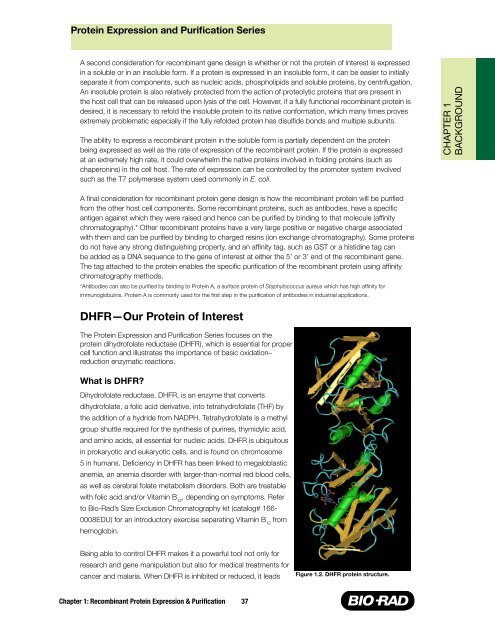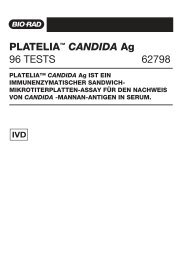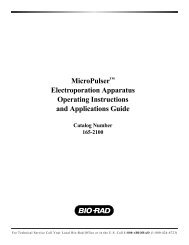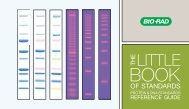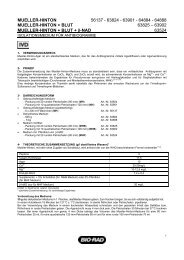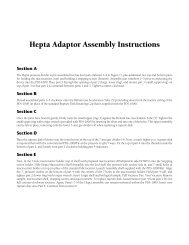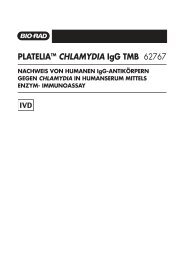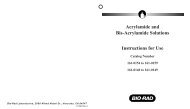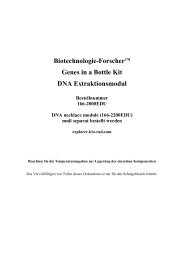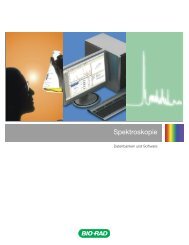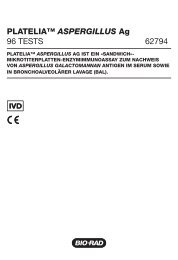Protein Expression and Purification Series - Bio-Rad
Protein Expression and Purification Series - Bio-Rad
Protein Expression and Purification Series - Bio-Rad
Create successful ePaper yourself
Turn your PDF publications into a flip-book with our unique Google optimized e-Paper software.
<strong>Protein</strong> <strong>Expression</strong> <strong>and</strong> <strong>Purification</strong> <strong>Series</strong><br />
A second consideration for recombinant gene design is whether or not the protein of interest is expressed<br />
in a soluble or in an insoluble form. If a protein is expressed in an insoluble form, it can be easier to initially<br />
separate it from components, such as nucleic acids, phospholipids <strong>and</strong> soluble proteins, by centrifugation.<br />
An insoluble protein is also relatively protected from the action of proteolytic proteins that are present in<br />
the host cell that can be released upon lysis of the cell. However, if a fully functional recombinant protein is<br />
desired, it is necessary to refold the insoluble protein to its native conformation, which many times proves<br />
extremely problematic especially if the fully refolded protein has disulfide bonds <strong>and</strong> multiple subunits.<br />
The ability to express a recombinant protein in the soluble form is partially dependent on the protein<br />
being expressed as well as the rate of expression of the recombinant protein. If the protein is expressed<br />
at an extremely high rate, it could overwhelm the native proteins involved in folding proteins (such as<br />
chaperonins) in the cell host. The rate of expression can be controlled by the promoter system involved<br />
such as the T7 polymerase system used commonly in E. coli.<br />
A final consideration for recombinant protein gene design is how the recombinant protein will be purified<br />
from the other host cell components. Some recombinant proteins, such as antibodies, have a specific<br />
antigen against which they were raised <strong>and</strong> hence can be purified by binding to that molecule (affinity<br />
chromatography).* Other recombinant proteins have a very large positive or negative charge associated<br />
with them <strong>and</strong> can be purified by binding to charged resins (ion exchange chromatography). Some proteins<br />
do not have any strong distinguishing property, <strong>and</strong> an affinity tag, such as GST or a histidine tag can<br />
be added as a DNA sequence to the gene of interest at either the 5' or 3' end of the recombinant gene.<br />
The tag attached to the protein enables the specific purification of the recombinant protein using affinity<br />
chromatography methods.<br />
*Antibodies can also be purified by binding to <strong>Protein</strong> A, a surface protein of Staphylococcus aureus which has high affinity for<br />
immunoglobulins. <strong>Protein</strong> A is commonly used for the first step in the purification of antibodies in industrial applications.<br />
DHFR—Our <strong>Protein</strong> of Interest<br />
The <strong>Protein</strong> <strong>Expression</strong> <strong>and</strong> <strong>Purification</strong> <strong>Series</strong> focuses on the<br />
protein dihydrofolate reductase (DHFR), which is essential for proper<br />
cell function <strong>and</strong> illustrates the importance of basic oxidation–<br />
reduction enzymatic reactions.<br />
What is DHFR?<br />
Dihydrofolate reductase, DHFR, is an enzyme that converts<br />
dihydrofolate, a folic acid derivative, into tetrahydrofolate (THF) by<br />
the addition of a hydride from NADPH. Tetrahydrofolate is a methyl<br />
group shuttle required for the synthesis of purines, thymidylic acid,<br />
<strong>and</strong> amino acids, all essential for nucleic acids. DHFR is ubiquitous<br />
in prokaryotic <strong>and</strong> eukaryotic cells, <strong>and</strong> is found on chromosome<br />
5 in humans. Deficiency in DHFR has been linked to megaloblastic<br />
anemia, an anemia disorder with larger-than-normal red blood cells,<br />
as well as cerebral folate metabolism disorders. Both are treatable<br />
with folic acid <strong>and</strong>/or Vitamin B , depending on symptoms. Refer<br />
12<br />
to <strong>Bio</strong>-<strong>Rad</strong>’s Size Exclusion Chromatography kit (catalog# 166-<br />
0008EDU) for an introductory exercise separating Vitamin B from 12<br />
hemoglobin.<br />
Being able to control DHFR makes it a powerful tool not only for<br />
research <strong>and</strong> gene manipulation but also for medical treatments for<br />
cancer <strong>and</strong> malaria. When DHFR is inhibited or reduced, it leads Figure 1.2. DHFR protein structure.<br />
Chapter 1: Recombinant <strong>Protein</strong> <strong>Expression</strong> & <strong>Purification</strong><br />
37<br />
CHAPTER 1<br />
BACKGROUND


